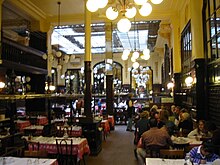Bouillons
The bouillons (derived from the French bouillon 'meat broth') were restaurants in France in the 19th and 20th centuries, where you could eat quickly, well and cheaply.
They were invented by the butcher Pierre-Louis Duval in Paris in 1855 and were simple restaurants where the market people and factory workers could eat. He offered a single menu and soup there for a minimal price.
history
In 1896 the Chartier brothers opened their first bouillon on Rue du Faubourg Montmartre ( 9th arrondissement ). It was the largest bouillon to date with a luxurious decor in the Art Nouveau style . The bouillons quickly became a 19th century Parisian institution. Here the workers, who often had no cooking facilities in their accommodations, got a filling, warm meal at a reasonable price. Around 1900 there were 25 such bouillons in Paris . Some middle-class variants of these bouillons also had reading rooms and entertaining attractions. The first Bouillon Grandon-Duval was created in 1899 in an old restaurant by the owner and architect Edouard Fournier . In 1904, the Chartier brothers created another bouillon on Boulevard Saint-Germain , which later became the Vagenende restaurant . In 1906, the architect Jean-Marie Bouvier , together with Louis Trézel , created other bouillons : the Grand Bouillon Camille Chartier on Rue Racine and the Bouillon Edouard Chartier on Boulevard du Montparnasse . Only a few of these bouillons have survived to this day. Of these four, only the Chartier and the Bouillon Racine have the original spirit and retain the Art Nouveau interior.
Chez Chartier
The Chez Chartier at 7, rue du Faubourg-Montmartre in Paris consists of a large dining room and is located in a back courtyard. The furnishings have not changed since it opened in 1896. The original decor of wood, brass, glass, mirrors, paintings, ceramics, revolving doors, as well as hundreds of small drawers and boxes on the walls, in which the regular customers kept their cutlery, are still preserved.
Bouillons in Paris
- Le Grand Colbert in the Colbert Gallery
- Broth Racine at the Sorbonne
